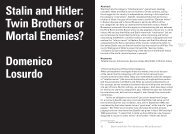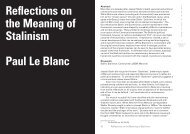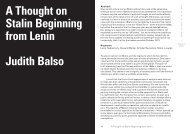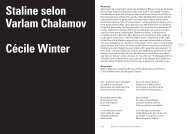adrian
adrian
adrian
- No tags were found...
You also want an ePaper? Increase the reach of your titles
YUMPU automatically turns print PDFs into web optimized ePapers that Google loves.
characteristic of the Unhappy Consciousness of Self-Consciousness.Utilizing his non-subjectivist logical language, Hegel here employsthe structure of the syllogism so as to establish the parallels andcontinuities between Self-Consciousness and Reason: Vernunft,first incarnated as the rational scientific observer of nature, becomesaware of itself as a syllogistic middle term (i.e., the mediator assumingthe position previously occupied for Unhappy Consciousness by thepriest as clerical conduit mediating relations with the divine) between,on the one hand, a universal term (i.e., God qua the Unchangeablebecome the God’s-eye “view from nowhere” of modern science’smethodologically secured objective viewpoint on the world) and, on theother hand, a particular term (i.e., the individual persons qua membersof the congregation/flock become the specific empirical entities andevents of concern to the scientist). 88 This syllogistic formulation helpsfurther sharpen the distinction between Consciousness (particularlyas Sense-Certainty and Perception) and Reason: Not only, as I alreadynoted, is Consciousness passive and Reason active (with this emphasison activity reflecting Reason’s successor position as an inheritor ofthe intervening legacies of Self-Consciousness)—while the objectsof Consciousness are conceived by it nominalistically as sensoryperceptualindividualities qua utterly unique thises, thats, and others,the “same” objects are, for Vernunft in its modern scientific shape,particular embodiments or manifestations of universal patterns andrules (i.e., laws amenable to formalized generalizations, such as causallaws of nature). That is to say, Reason’s primary concern is with what isintelligibly universal in sensuous particulars, whereas Consciousnessis fixated on and in thrall to the latter alone 89 (a point Hegel laterunderscores in his Berlin-era history-of-philosophy lecture on Bacon 90 ).Now, having clarified the historical and (phenomeno)logicalbackdrop to Reason as the preliminary appearance of what proceedsto become Hegelian absolute idealism proper (or, one could say, ofVernunft as the an sich of absolute idealism an und für sich), I stillhave to respond directly to two questions raised by prior stretches ofmy preceding remarks: First, how does Hegel’s implicit reference toBacon in 1807 inform his appropriation of Kant’s transcendental unity ofCRISIS&CRITIQUE#3apperception (both in the Phenomenology itself as well as the passageof the Science of Logic repeatedly brandished by Pippin)? Second, howdoes the answer to the previous question affect Pippin’s interpretationof apperception in Hegel’s idealism? Apropos the first of these queries,Hegel reverses Kant’s above-cited narrative, in the preface to theB-version of the first Critique, about the relationship between Bacon andcritical transcendental idealism. Kant sees the Copernican revolutionof his idealism as the consequent advancement and coming to fruitionof the germinal seed of Bacon’s insight into the necessary contributionof the inquirer’s subjective activities to what is revealed as the objectivecontent of true knowledge in and through these same inquiries. Bycontrast, for Hegel, Kant’s (subjective) idealism is retrograde incomparison with Bacon’s proto-idealism, lagging behind what it claimsto be merely one of its historical precursors. Not (yet) burdened bythe baggage of an anti-realist subjectivism freighted with fatal, (self-)dialecticizing inconsistencies, Bacon, with his combination of anempiricist, naturalist realism and proto-idealist appreciation of activesubjectivity as a co-constituter of known reality, is philosophically closerto Hegel’s absolute idealist metaphysics than is Kant’s transcendentalidealist epistemology chronologically (and geographically/culturally)closer to Hegel. Even in the Phenomenology, the logical arguablyhas priority over the chronological, one consequence of this beingthat speculative solutions to dialectical problems sometimes occurhistorically out of sequence, with answers to questions surfacingin linear historical time before the questions themselves have been(explicitly) posed. 91 By Hegel’s lights, the Bacon-Kant relationship isan illustration of precisely this: Baconian Vernunft already overcomesthe self-subverting one-sidedness of the subjectivism of Kantiancritical-transcendental idealism in a manner foreshadowing Hegel’sown absolute idealist sublation of Kantianism. In line with the Vernunftof Hegelian absolute idealism, Bacon already sketches the rudimentarycontours of an immanent unity of apperception—more precisely, sucha unity as a subjectivity sharing a dialectical-speculative identity-indifferencewith objectivity within an overarching one-world metaphysics(as opposed to Kant’s two-worlds metaphysics). 92Apropos the question of how the immediately preceding impactsCRISIS&CRITIQUE#388 Hegel 1977c, p. 139.89 Hegel 1977c, pp. 139, 147-149, 154; Johnston 2012, pp. 119-120.91 Johnston 2014c.90 Hegel 1955b, pp. 175-177.92 Johnston 2012, pp. 118-121.394 “Where to Start?: Robert Pippin, Slavoj Žižek...395“Where to Start?: Robert Pippin, Slavoj Žižek...






